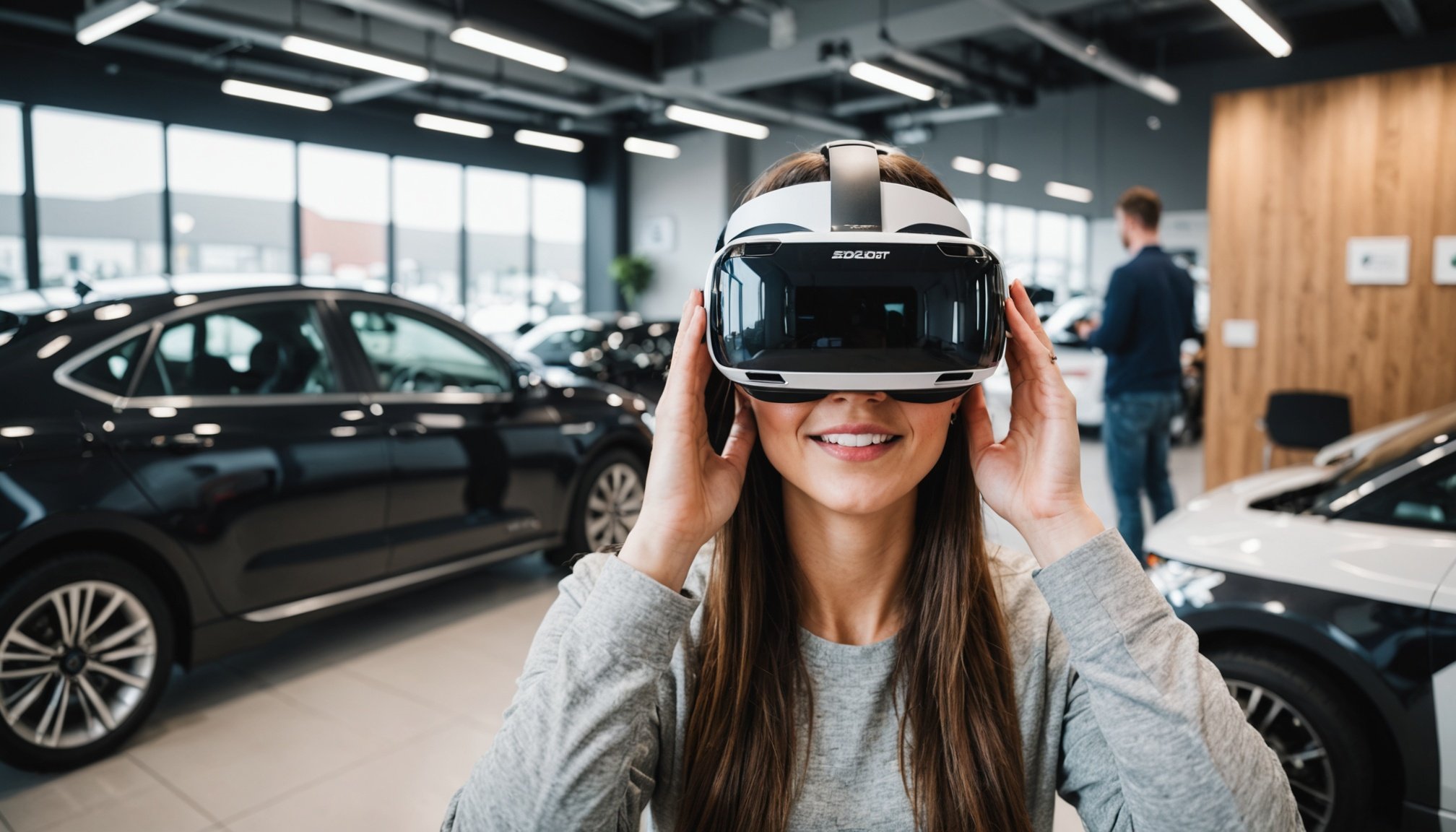Overview of Virtual Reality in Automotive Sales
In recent years, the landscape of the automotive sales industry has been significantly shaped by the introduction of virtual reality (VR). VR technology allows potential buyers to explore VR showrooms, providing a unique, immersive experience that traditional methods cannot match. This innovation is becoming increasingly relevant in the UK, where dealerships are racing to integrate automotive technology that captivates and engages customers.
Across the UK, dealerships are beginning to acknowledge the influence of VR as a sales tool, with industry leaders predicting a swift uptake in its adoption. For example, rather than just reading specifications or seeing photographs, customers can now ‘sit’ in a virtual car, realising the sensation of driving without leaving the showroom. Such technology enhances consumer decision-making—bridging the gap between digital browsing and physical experience.
Also read : Top strategies for uk companies to protect data integrity in the cloud
The trend towards technology adoption in UK dealerships reflects a broader shift towards digital transformation in automotive sales. Yet, transitioning to VR can also pose challenges, necessitating training and adaptation among sales teams to maximise its potential. Dealerships embracing these trends successfully will likely gain a competitive edge, leveraging VR to improve customer satisfaction and ultimately, drive sales.
Implementation of VR Showrooms in UK Dealerships
Incorporating VR implementation into the automotive sector is a growing trend in the UK, revolutionizing traditional dealership technology. Virtual showrooms offer a wide range of possibilities, not merely enhancing the visual experience but also transforming how cars are sold and bought.
Have you seen this : Harnessing user-generated content: a comprehensive guide for uk beauty brands to supercharge their marketing strategies
Examples of UK Dealerships Using VR
Several UK dealerships have pioneered in the realm of virtual showrooms. Some have blended immersive VR experiences into their sales strategies, allowing customers to explore multiple vehicle options beyond physical inventory constraints. This approach not only optimizes space but also significantly broadens the scope of available choices.
Features of VR Showrooms
Key features like high-resolution 3D models, interactive controls, and virtual test drives are at the forefront of dealership technology. These features allow customers to simulate real-world driving conditions, providing a closer-to-reality experience without requiring a visit to the dealership. This technology enhances customer interaction, making the car-buying process more engaging and informed.
Customer Engagement Strategies
To boost customer engagement, dealerships use personalized virtual tours and tailored online journeys. VR implementation helps by enabling features such as virtual consultations and guided tours, offering more than just visuals. These strategies aim to elevate customer satisfaction, ultimately leading to informed decisions and a seamless buying experience.
Impact of VR on Revenue Growth
The adoption of virtual reality (VR) has brought about a significant transformation in dealership operations. Revenue growth has been notably impacted, with dealerships witnessing improved sales performance. Before VR, sales processes were lengthy and often reliant on physical inventory. Now, with VR, customers can experience products virtually, significantly enhancing buying processes.
Statistics reveal a noticeable increase in dealership profits post-VR adoption. For instance, dealerships incorporating VR report an average 25% boost in sales performance, attributed mainly to enhanced customer engagement and streamlined operations. This boost is largely because VR enables customers to visualize and interact with vehicles in a virtual space, reducing the time from showroom visit to purchase decision.
The impact varies across different dealership types. Luxury dealerships often see higher revenue growth, capitalizing on the enhanced customer experience VR provides. Mainstream dealerships also benefit, albeit to a lesser extent, reflecting the broad appeal of immersive technology.
Looking ahead, the ongoing implementation promises continued revenue growth. Predictions suggest that dealerships maximizing VR capabilities could see up to a 40% increase in profits within the next five years. As technology evolves, it’s expected that even more dealerships will leverage VR, cementing its role as a key driver of revenue enhancement.
Benefits of VR for Customers and Sellers
Virtual Reality (VR) technology is revolutionising the way customers and sellers interact, offering numerous advantages. Whether enhancing the customer experience or providing substantial seller benefits, VR is shaping the future of shopping and sales.
Enhancing Customer Experience
VR technology enhances the customer experience by offering immersive and interactive environments. When used during car shopping, VR allows customers to virtually explore different models, colours, and interior options without the need to physically visit multiple dealerships. This convenience saves time and makes the decision-making process more engaging and personalised.
Efficiencies for Dealerships
For dealerships, implementing VR yields significant efficiency gains. By reducing the need to maintain a large physical inventory, dealerships can lower operational costs. Virtual showrooms allow sales teams to focus on customer service rather than logistical challenges, streamlining operations significantly.
Competitive Advantage
Gaining a competitive edge in a crowded market is a major benefit for dealerships adopting VR. By offering a unique and modern shopping experience, dealerships can attract tech-savvy customers who value innovation. Additionally, the ability to provide detailed virtual demonstrations can lead to higher conversion rates, setting VR-integrated dealerships apart from competitors relying on traditional methods.
Case Studies of Successful VR Adoption
In the realm of virtual reality (VR), several success stories stand out for their exemplary execution and significant impact. One vivid example is a detailed case study from a leading UK dealership that embraced VR to innovate customer experience and enhance sales. By integrating VR, the dealership allowed potential buyers to interactively explore a diverse range of vehicles in a virtual showroom. This not only boosted engagement but also led to an observable increase in conversion rates.
Furthermore, a comparison of VR adoption outcomes among various dealerships reveals insightful variations. Some dealerships experienced a transformation in customer satisfaction and decreased sales cycles, while others struggled to seamlessly integrate the technology into their existing systems. Factors such as employee training, customer preferences, and initial infrastructure challenges influenced these outcomes significantly.
Key lessons from successful VR implementations underscore the importance of strategic planning and stakeholder involvement. Comprehensive training programs and continuous support systems were pivotal in overcoming technological barriers and ensuring smooth transitions. Additionally, a tailored approach that considers the unique needs and demographics of the target market was crucial in maximising VR’s potential. These stories set a precedent for future adopters aiming to harness VR’s transformative capabilities effectively.
Challenges and Solutions in Adopting VR Technology
The advent of Virtual Reality (VR) in various industries presents both exciting opportunities and potential challenges. Understanding these barriers is crucial for successful technology adoption.
Common Barriers to VR Adoption
One of the primary challenges in adopting VR technology is the high cost associated with implementation. Setting up VR environments requires significant investment in specialized hardware and software, which can be prohibitive for smaller dealerships. Moreover, technological expertise is another hurdle, as staff may need training to operate and maintain VR systems effectively. Concerns about compatibility with existing systems and data security also pose significant worries, as businesses aim to protect sensitive information while integrating new tech.
Technological Solutions
To address these challenges, companies are exploring cost-effective solutions. Leasing VR equipment instead of purchasing can reduce the initial financial burden. Training programs and workshops can enhance staff proficiency, resolving the expertise issue. For compatibility and security fears, robust encryption and regular software updates are recommended to prevent data breaches. Additionally, cross-platform technologies can ensure VR systems work seamlessly with current infrastructure.
Future Outlook
Looking ahead, the future of VR adoption in the automotive industry looks promising. As technology advances, costs are expected to decrease, making VR more accessible. Continuous innovations and improvements in VR will likely streamline the integration process, leading to wider acceptance and utilization across dealerships and other sectors.











